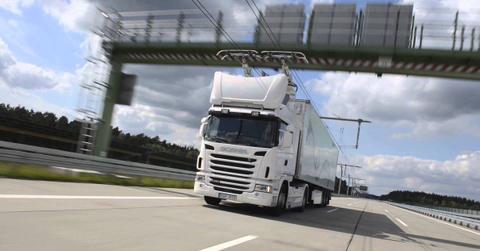California's First Electric Highway Is Finally Open
Siemens has developed the eHighway since 2012, and after success in Europe, it's finally in the US. The trial run stretches between Los Angeles and Long Beach, and there's potential for it to aid California's zero emission freight goal for 2050.
Updated May 17 2019, 12:55 p.m. ET
California is the newest destination for a Siemens’ eHighway system. What exactly is an eHighway? The mile-long electric highway is able to power electric trucks with overhead cables. The goal of this is to showcase potential for zero-emission cargo transportation. Right now, the eHighway is about a mile long, and runs between ports in Los Angeles and Long Beach.
Interestingly, California's electric highway isn't the first in the world. Siemens started the eHighway concept back in 2012, where Germany was the host of hybrid commercial vehicles that were connected and powered by electric cables in the sky. As the largest industrial manufacturing company in Europe, they needed find a solution to avoid large electric trucks from needing to stop and charge. Another demo highway is located in Sweden.
If the eHighway is feasible in urban environments, they could create an enormous change in carbon emissions. Large vehicles can be powered by cables for long distances while ports located in Los Angeles and Long Beach would have significantly less smog. Three different trucks will be used on California’s test road: a fully electric truck, a compressed hybrid truck, and a hybrid big rig. Other vehicles can use the road at the same time.
“To have the road electrified and have these heavy trucks electrified is just far more efficient from the perspective that you don’t waste fuel,” Andreas Thon, head of electrification projects at Siemens’ North American division, told Fast Company. “You save energy because the electric motor is far more efficient than the gas motor, and you have no emissions at all.”
While there have been strides in electrifying large vehicles, this is limited to shorter delivery ranges and times. Unfortunately, there isn’t a convenient way to do it for trucks that need to go long distances. Weight itself requires a substantial amount of battery power, meaning that trucks would have to stop and charge for up to an hour every few miles. The eHighway would also be ideal for shuttle and freight transport.
Being attached to a cable sounds daunting in theory, but it isn’t actually any different from driving a traditional diesel truck. The pantograph connected to the cables can disconnect either manually or automatically, and they will shift with the vehicle. Anytime there’s a lane change out of the electrified route, the pantograph will automatically disconnect.
"This project will help us evaluate the feasibility of a zero-emission cargo movement system using overhead catenary wires," South Coast Air Quality Management District's Wayne Nastri told Forbes. "This demonstration could lead to the deployment of eHighway systems that will reduce pollution and benefit public health for residents living near the ports."
In the future, Siemens hopes to charge vehicles from underneath the road. The technology is under development, but it’s more important for the company to install the eHighway at more places in its current form. If expectations are met, the highway could be extended throughout California to help meet the state’s goals for emissions-free freight transport by 2050.
